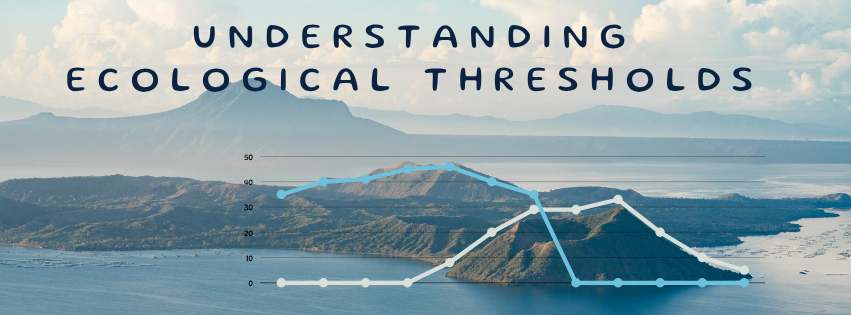Ecological thresholds are critical points where a small change in an environmental variable can trigger an abrupt transformation in the system. Far from being merely technical tools, thresholds enable us to detect tipping points in ecosystem dynamics and have profound implications for conservation, environmental management, and policy design.
What is an ecological threshold?
An ecological threshold is the value of an independent variable (such as temperature, vegetation cover, nutrient concentration, etc.) at which a sudden shift occurs in the ecosystem’s state or behavior (Muradian, 2001). In other words, the system can tolerate change up to a certain point, but once that threshold is crossed, it may become unstable, shift to a new state, or lose essential functions.
Where are thresholds applied?
1. Detecting spatial hotspots
 Spatial thresholds are used to identify biodiversity or degradation hotspots across the landscape. Nelson and Boots. (2008) applied density-based thresholds to detect critical areas in land-use mosaics and assess whether spatial patterns were random or structured. Example: using a vegetation cover threshold to determine whether a habitat patch is suitable for a species.
Spatial thresholds are used to identify biodiversity or degradation hotspots across the landscape. Nelson and Boots. (2008) applied density-based thresholds to detect critical areas in land-use mosaics and assess whether spatial patterns were random or structured. Example: using a vegetation cover threshold to determine whether a habitat patch is suitable for a species.
2. State transitions in ecosystems
 Majumder et al. (2019) used spatial data to infer thresholds in transitions between alternative stable states (e.g., from a healthy forest to a degraded one). In shallow lakes, a clear state dominated by macrophytes can shift abruptly to a turbid state dominated by cyanobacteria once nutrient levels exceed a certain threshold (Muradian, 2001).
Majumder et al. (2019) used spatial data to infer thresholds in transitions between alternative stable states (e.g., from a healthy forest to a degraded one). In shallow lakes, a clear state dominated by macrophytes can shift abruptly to a turbid state dominated by cyanobacteria once nutrient levels exceed a certain threshold (Muradian, 2001).
3. Disturbance management
 Some ecosystems, such as grasslands, can suddenly shift to shrub-dominated states if thresholds in grazing pressure or fire frequency are exceeded (Muradian, 2001). Once that threshold is crossed, reverting the system may require intensive interventions.
Some ecosystems, such as grasslands, can suddenly shift to shrub-dominated states if thresholds in grazing pressure or fire frequency are exceeded (Muradian, 2001). Once that threshold is crossed, reverting the system may require intensive interventions.
Types of thresholds
Depending on the ecological context, thresholds can be classified as:
| Type of threshold | Definition | Example |
|---|---|---|
| Fixed/arbitrary | Based on reference values or standards | Probability > 0.5 in species distribution models |
| Empirical | Derived from data using statistical or spatial analyses | Slope change in a diversity curve |
| Ecological/critical | Marks the point of functional system collapse | Loss of macrophytes due to nutrient overload |
| Operational | Chosen for convenience or manageability | Thresholds for binary conservation maps |
How are thresholds identified?
Thresholds in ecological systems can be identified through various analytical approaches, which often depend on the nature of the data and the system being studied. Majumder et al. (2019) highlight several techniques for detecting critical thresholds using spatial data. These include analyzing shifts in spatial autocorrelation, examining frequency distributions for discontinuities, identifying nonlinear relationships such as sigmoidal or “S-shaped” curves, and fitting models that represent alternative stable states. Each of these methods helps to reveal sudden changes in ecosystem behavior that may indicate the presence of a threshold.
In the context of landscape ecology, Nelson et al. (2008) propose evaluating thresholds by comparing observed spatial patterns to randomized patterns and assessing how threshold selection influences landscape metrics such as aggregation, contiguity, and dominance. These approaches are particularly useful in detecting the spatial scale or intensity at which ecological patterns become significantly different from random expectations.
Implications for environmental management
-
Sensitivity: A poorly chosen threshold can lead to incorrect decisions (e.g., falsely classifying areas as unsuitable).
-
Resilience: Identifying thresholds helps prevent crossing ecological points of no return.
-
Environmental policy: Thresholds can be translated into actionable standards (e.g., nutrient load limits for eutrophication).
Conclusion
Choosing a threshold is not just “picking a number.” It’s a decision that must be informed by ecological theory, empirical evidence, and the specific context of the analysis. As researchers, we must be transparent, justify, and, whenever possible, validate the thresholds we use.
This blog is continuously being updated as new insights emerge. If you have any experience, suggestions, or observations related to threshold selection in ecological models, please don’t hesitate to contact me and share your thoughts. Your input can help enrich this space and foster a deeper understanding of the ecological decisions we make.

